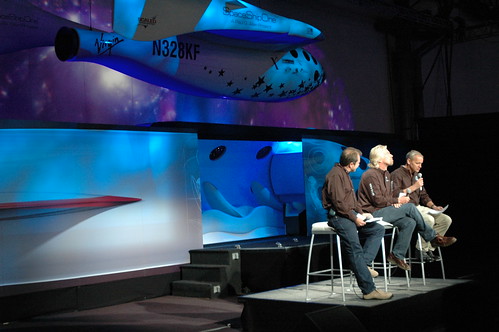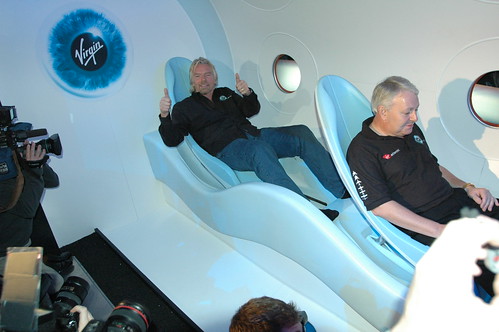 I'm at the Javits Center in New York City for Wired magazine's NextFest 2006, where the Virgin Group's chief Richard Branson (center), Virgin Galactic president Will Whitehorn (left), and V.P. of astronaut relations Steve Attenborough this morning unveiled an interior mockup of Virgin's planned tourist spaceship, SpaceShipTwo.
I'm at the Javits Center in New York City for Wired magazine's NextFest 2006, where the Virgin Group's chief Richard Branson (center), Virgin Galactic president Will Whitehorn (left), and V.P. of astronaut relations Steve Attenborough this morning unveiled an interior mockup of Virgin's planned tourist spaceship, SpaceShipTwo.The Virgin crew stressed that the interior was a concept only, but that it was very close to the design being built by Scaled Composites in Mojave California. The outside of the ship will be kept secret until its expected unveiling by Scaled late next year. A model of SpaceShipOne hung above the mockup to give a sense of scale.
SpaceShipTwo's passenger cabin will enclose 1,000 cubic feet, which felt spacious when I stepped inside it (shoes off first, please, entreated Virgin employees).
 There's Branson, sans shoes, along with Alan Watts, the very first Virgin Atlantic frequent flier with enough miles (two million of them) for a trip to space.
There's Branson, sans shoes, along with Alan Watts, the very first Virgin Atlantic frequent flier with enough miles (two million of them) for a trip to space.After dropping from a jet-powered mother ship and firing its single rocket motor to reach space, the six passengers on board will be able to unbuckle their restraints to float free in the cabin.
Virgin initially planned a tether system to reel passengers back into their seats in time for the spaceship's reentry after four or five minutes of weightlessness. It's a simpler design without tethers, said Whitehorn. Preflight training will help passengers return to their seats, and even if they don't make it in time they will still be able to lie down on the floor for an equally comfortable reentry, said Whitehorn.
A bulkhead separating the passenger cabin from the two pilots in the cockpit will keep flying passengers safely away from control panels.

Though not part of the mockup, four big round analog dials will show passengers their speed, in multiples of the speed of sound (Mach), their g loads, altitude, and probably mission elapsed time, though Whitehorn wasn't completely sure about that last one when I asked him.
A display will show exterior camera views of the spaceship throughout the flight, while windows all around the fuselage will give passengers the best possible views as the ship slowly rolls at the top of its suborbital arc.


